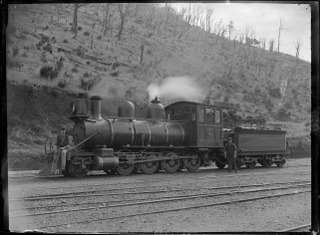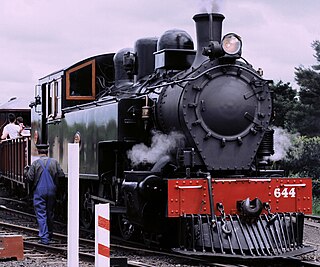
The New Zealand F class was the first important class of steam locomotive built to operate on New Zealand's railway network after the national gauge of 3 ft 6 in was adopted. The first locomotives built for the new gauge railways were two E class double Fairlies for the Dunedin and Port Chalmers Railway Company. The F class was the first class ordered by the central government, and between 1872 and 1888, a total of eighty-eight members of the class were constructed.

The NZR A class were a class of steam locomotives built in 1906 with a 4-6-2 wheel arrangement for the New Zealand Railways Department (NZR). The class should not be confused with the older and more obscure A class of 1873. They were designed by the NZR's Chief Mechanical Engineer, A. L. Beattie and his Chief Draughtsman, G. A. Pearson to replace less powerful locomotives struggling with increasing loads on the South Island Main Trunk Railway, and in anticipation of the traffic volumes that would be created upon the completion of the North Island Main Trunk railway.

The NZR WB class was a class of tank locomotives that operated in New Zealand. Built in 1898 by the Baldwin Locomotive Works, the twelve members of the class entered service during the first five months of 1899. Eight were withdrawn by the end of 1935, while four others survived with new boilers until the mid-1950s.

The NZR O class consisted of six steam locomotives that operated on New Zealand's national rail network. Ordered from the Baldwin Locomotive Works of Pennsylvania in 1885, three arrived in time to begin work in December 1885, while two more were placed in service in January 1886 and the sixth in February 1886. After almost four decades of service, all six were withdrawn in May 1922. None survived to be preserved, although two engine frames and 5 tenders from O class locomotives are known to exist near Summit on the former Rimutaka Incline.
The NZR NA class was a class of two steam locomotives that operated on the privately owned Wellington and Manawatu Railway (WMR) and then the publicly owned New Zealand Railways (NZR). Ordered by the WMR to operate on its line up the west coast of the North Island north of Wellington, the first was built in 1894 by the Baldwin Locomotive Works and entered service that year as WMR No. 14. In 1896, a second locomotive that was slightly more powerful was ordered from Baldwin, and it entered service in October 1897. The engines were similar to the two members of the N class ordered in 1891, except they were heavier and more powerful. They were Vauclain compound locomotives.

The Wellington and Manawatu Railway Trust is a charitable trust based in Wellington, New Zealand, and is actively restoring former Wellington and Manawatu Railway locomotive No.9, to full working order.

The NZR NC class was a class of two steam locomotives built by Baldwin Locomotive Works built for service on New Zealand's private Wellington and Manawatu Railway (WMR). They did not acquire their NC classification until the publicly owned New Zealand Railways Department (NZR) purchased the WMR and its locomotive fleet.

The OB class was the first class of steam locomotives constructed by the Baldwin Locomotive Works for the Wellington and Manawatu Railway Company (WMR) in New Zealand. The class consisted of two locomotives ordered in 1888, and they entered service in September of that year as WMR No.'s 11 and 12.

The OA class is a solitary steam locomotive built by the Baldwin Locomotive Works for the Wellington and Manawatu Railway (WMR) in New Zealand. Ordered in 1894, it entered service in August of that year as No. 13 and was the first narrow gauge Vauclain compound in the world. In 1908, the WMR and its locomotive fleet were purchased by New Zealand Railways Department (NZR) and incorporated into the national rail network, and, although No. 13 bore a likeness to members of the O class, it was sufficiently different that it warranted separate classification. The designation of OA was created and it was numbered OA 457. It operated for another two decades until it was withdrawn in December 1929 in Auckland. The locomotive was known to WMR staff as "The Lady".

The OC class, built by the Baldwin Locomotive Works for the Wellington and Manawatu Railway (WMR) in New Zealand, consists of a solitary steam locomotive. Ordered in 1896 as an externally similar but more powerful version of the OA class locomotive ordered in 1894, it entered service in June 1897 as No. 16. It was a Vauclain compound locomotive.

The New Zealand E class locomotive comprised a single Mallet steam locomotive operated by New Zealand Railways (NZR) from 1906 until 1917. Classified as E 66 and nicknamed Pearson's Dream after its designer, it was an experimental Mallet locomotive designed to work on the Rimutaka Incline. The "E" classification was previously used by the Double Fairlie E class of 1872-75, but the classification was free as they had all been withdrawn by the time E 66 entered service. After the withdrawal of E 66, "E" was again re-used on the battery-electric E class of 1922. It was the only Mallet locomotive to operate for the NZR

The BC class comprised a single steam locomotive that operated on New Zealand's national rail network. Built for the Wellington and Manawatu Railway (WMR) and classified simply as No.17, it passed into the ownership of the New Zealand Railways Department (NZR) when the government purchased the WMR in December 1908, and it was then that it acquired the BC classification as BC 463.

The Napier Express was a passenger express train operated by the New Zealand Railways Department initially between Napier and Palmerston North and later between Napier and Wellington. It ran from 1891 until 1954.

The New Plymouth Express was a passenger express train operated by the New Zealand Railways Department (NZR) between Wellington and New Plymouth. It ran from 1886 until 1955 and was sometimes known as the New Plymouth Mail due to the Railway Travelling Post Office carriages included in its consist. The Express was notable amongst NZR's provincial expresses as being both the first and, until the commencement of the Gisborne Express in 1942, the longest in distance travelled.

The New Zealand V class steam locomotive was used on New Zealand's railway network from 1885 onwards. They were operated by New Zealand Government Railways and the Wellington and Manawatu Railway Company.

The NZR UD class was a class of two 4-6-0 steam locomotives built by the Baldwin Locomotive Works in 1904 for the Wellington and Manawatu Railway Company. When that company was nationalised in 1908, they passed into the ownership of the New Zealand Railways and received the designation UD.

The Wellington and Manawatu Railway Company was a private railway company that built, owned and operated the Wellington-Manawatu railway line between Thorndon in Wellington, the capital of New Zealand, and Longburn, near Palmerston North in the Manawatu, between 1881 and 1908, when it was acquired by the New Zealand Government Railways. Its successful operation in private ownership was unusual for early railways in New Zealand.

The NZR WJ class was a class of one steam locomotive built by Baldwin Locomotive Works for service on New Zealand's private Wellington and Manawatu Railway (WMR). She acquired the WJ classification when the publicly owned New Zealand Railways Department (NZR) purchased the WMR and its locomotive fleet in 1908.

The NZR WH class was a class of three steam locomotives built by Manning Wardle in 1884 for service on New Zealand's private Wellington and Manawatu Railway Company (WMR). They did not acquire their WH classification until 1908 when WMR was nationalised and incorporated into the New Zealand Government Railways (NZR). A total of five locomotives were purchased by the WMR but two had been sold by the time NZR took over the company.

The New Zealand WW class was a class of 4-6-4T tank locomotives that operated on the New Zealand national railway network. They were built for New Zealand Railways Department (NZR), and were the final development of the six-coupled tank engine in New Zealand, the penultimate class of tank locomotives to be built for NZR, and the first class of tank locomotives to be built with superheaters.


















